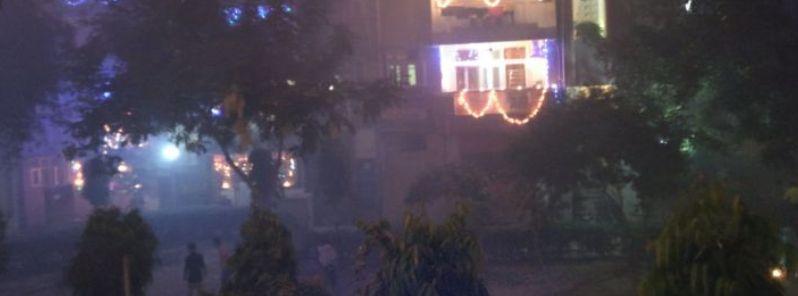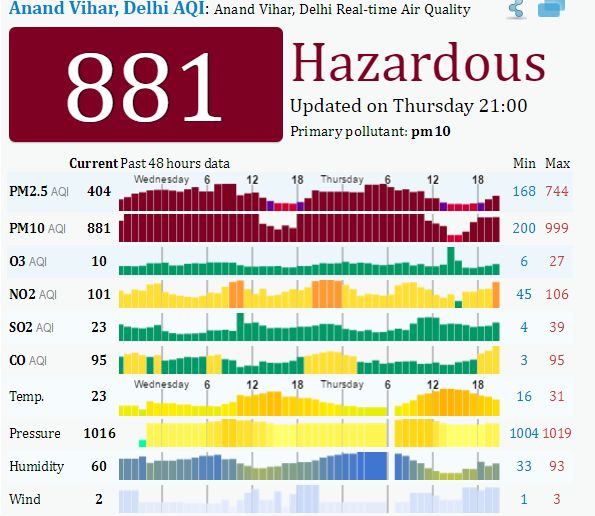Hazardous smog wraps Delhi, the worst in last 17 years

A thick layer of hazardous smog blanketed New Delhi, India four days ago and shows no sign of loosening the grip.
On November 3, 2016, between 07:00 and 09:00 (local time), Palam Observatory reported the dense smog layer has dropped the visibility to only 50 m (164 feet). The conditions have improved somewhat during the day, although the visibility hasn't cleared completely.

Video credit: NDTV
The Central Pollution Control Board (CPCB) reported an Air Quality Index (AQI) of 494, a severe category, in Anand Vihar on the morning of November 2. Several areas around Delhi measured PM2.5 and PM10 particulate matter levels, well above the safe limits. The PM2.5 levels were in the range between 408 microns per cubic meter and more than 500 microns per cubic meter while PM10 levels ranged between 392 and over 500 microns per cubic meter.
On the same day, several places across Delhi-NCR showed PM2.5 and PM10 levels were much above the safe limits. PM2.5 levels were observed between 408 microns per cubic meter and over 500 microns per cubic meter. Meanwhile, PM10 levels were in the range of 392 microns per cubic meter to over 500 microns per cubic meter.


AQI and meteorological parameters reported in Delhi on November 3, 2016, 21:00 (local time). Image credit: aqicn.org
AQI of 881, reaching hazardous levels was measured in Anand Vihar on November 3, 21:00 (local time).
According to the Indian Meteorological Department, this is the worst smog event in the last 17 years. The Indira Gandhi International Airport measured the worst smog level in the last 17 years on November 2, as the visibility was only 300 to 400 m (984.2 to 1 312.3 feet). The Center for Science and Environment (CSE) has urged the government to put in effect plans for controlling winter pollution and issue health advisories for residents.
"The government should aggressively inform all and advise them to stay indoors and avoid outdoor exercises. At the same time, it should roll out stringent winter pollution control for all sources along with emergency action," said Anumita Roychowdhury, head of CSE's air pollution and sustainable mobility teams.
The pollution levels have significantly increased since October 30, and a thick brown smog layer was visible even during the afternoon hours. The low visibility has affected the traffic, and at least 20 vehicles got stranded on the highway near the capital. Several injuries have been reported from the incident, as well.


Video credit: Hindustan Times
Meteorological conditions have contributed to a low air quality index, Skymet Weather reported. Very light winds, low temperatures, and high humidity caused the pollutants to remain suspended in the low levels of the atmosphere. This was also emphasized by burning of crops in the neighboring states of Punjab and Haryana.
Experts warn the situation is not close to getting resolved.
“Until and unless wind speed will not increase up to 15-20 km/h (9.3-12.4 mph), there will be no change in the existing climatic conditions and we do not foresee any change till the weekend. Bright sunshine could also help but dense smog cover has not allowed sunrays to reach the surface," said Mahesh Palawat, the Chief Meteorologist of the Skymet Weather.
The Western Disturbance, forecast to pass in the period between November 6 and 7, could contribute to wind intensity, and may provide some relief.
Featured image: Delhi smog, captured during Diwali festivities, October 30, 2016. Image credit: @PranavDixit

Commenting rules and guidelines
We value the thoughts and opinions of our readers and welcome healthy discussions on our website. In order to maintain a respectful and positive community, we ask that all commenters follow these rules.